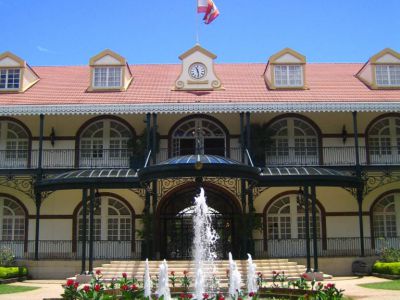Presidential Palace, Papeete
Mr. Gaston Flosse, re-elected President of French Polynesia in 1996, decided to build a house where the president could reside. By the year 2000, he had inaugurated his dream palace. It was a remake of the former Broche Barracks on the Avenue Bruat in Papeete.
The Barracks were part of a military installation built by the colonial administration in 1885, intended to provide military and administrative services and to be a center for the defense and protection of the civilian population. The area was named Broche in honor of the first head of the Pacific Batallion to serve in France in World War I.
The architect in charge of the project was Pierre Lacombe. His instructions were to preserve the aspect of colonial and military architecture of the 19th century but modernize the comfort.
Today's Palace is a two-story house with a veranda and galleries. Large, rounded arches line both levels. The roof has large dormers, each one centered above the arch below. The center dormer over the main entrance has a clock. The Palace has a garden with a fountain, flowers, and plants chosen to add an exotic touch to the architecture.
There is a car parking and access for disabled visitors. Special theme events and guided tours can be arranged. The Palace area is closed at night.
The Barracks were part of a military installation built by the colonial administration in 1885, intended to provide military and administrative services and to be a center for the defense and protection of the civilian population. The area was named Broche in honor of the first head of the Pacific Batallion to serve in France in World War I.
The architect in charge of the project was Pierre Lacombe. His instructions were to preserve the aspect of colonial and military architecture of the 19th century but modernize the comfort.
Today's Palace is a two-story house with a veranda and galleries. Large, rounded arches line both levels. The roof has large dormers, each one centered above the arch below. The center dormer over the main entrance has a clock. The Palace has a garden with a fountain, flowers, and plants chosen to add an exotic touch to the architecture.
There is a car parking and access for disabled visitors. Special theme events and guided tours can be arranged. The Palace area is closed at night.
Want to visit this sight? Check out these Self-Guided Walking Tours in Papeete. Alternatively, you can download the mobile app "GPSmyCity: Walks in 1K+ Cities" from Apple App Store or Google Play Store. The app turns your mobile device to a personal tour guide and it works offline, so no data plan is needed when traveling abroad.
Presidential Palace on Map
Sight Name: Presidential Palace
Sight Location: Papeete, Tahiti (See walking tours in Papeete)
Sight Type: Attraction/Landmark
Guide(s) Containing This Sight:
Sight Location: Papeete, Tahiti (See walking tours in Papeete)
Sight Type: Attraction/Landmark
Guide(s) Containing This Sight:
Walking Tours in Papeete, Tahiti
Create Your Own Walk in Papeete
Creating your own self-guided walk in Papeete is easy and fun. Choose the city attractions that you want to see and a walk route map will be created just for you. You can even set your hotel as the start point of the walk.
Papeete Waterfront Walk
Papeete, the capital of French Polynesia, is renowned for its beautiful natural setting. Still, other than lush green areas and stunning beaches, the city boasts a number of man-made sights well worth checking out. Papeete's Waterfront is a vibrant area bustling with activity and attractions that capture the essence of the island's culture and beauty.
Start your waterfront tour at... view more
Tour Duration: 1 Hour(s)
Travel Distance: 1.6 Km or 1 Miles
Start your waterfront tour at... view more
Tour Duration: 1 Hour(s)
Travel Distance: 1.6 Km or 1 Miles
Papeete Introduction Walking Tour
The islands of the Pacific were gradually settled by daring sea voyagers in large multiple hulled catamarans (canoes). Tonga and Samoa were reached by 1300 BC. By 500 BC, the Marquesas Islands were known to the navigators. Tahiti was settled between 300 and 800 AD.
Tahiti was divided into clan territories managed by chiefs and under-chiefs. Spanish explorers began arriving in the 16th century.... view more
Tour Duration: 2 Hour(s)
Travel Distance: 2.9 Km or 1.8 Miles
Tahiti was divided into clan territories managed by chiefs and under-chiefs. Spanish explorers began arriving in the 16th century.... view more
Tour Duration: 2 Hour(s)
Travel Distance: 2.9 Km or 1.8 Miles





